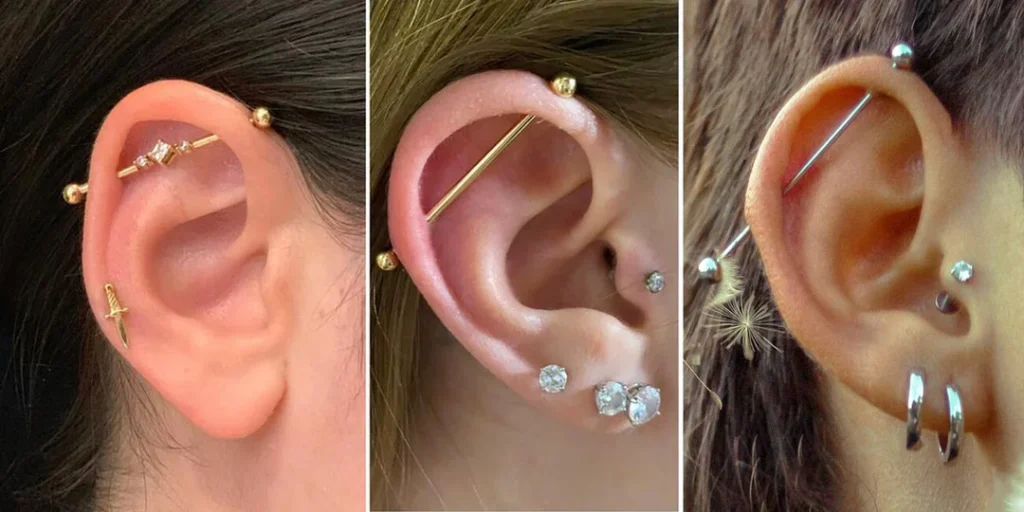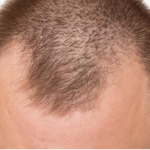Getting a helix piercing was something I had wanted for a long time. The helix piercing, which is placed on the upper part of the ear, looks super cool and stylish.
In this post, I’ll share my experience, from the pain level to the healing process. If you’re thinking about getting a helix piercing, keep reading to find out all the details!
What Is a Helix Piercing
A helix piercing is a type of ear piercing that goes through the cartilage on the upper part of your ear. Unlike lobe piercings, which are done on the soft part of the ear, the helix piercing is placed on the harder cartilage. This makes it a bit different and unique.
The helix piercing is very popular because it allows for a variety of earrings. You can wear tiny studs, elegant hoops, or even fancy designs. It’s a great way to add a bit of sparkle to your look.
When you get a helix piercing, it’s done with a needle, not a gun. This is to ensure the piercing is precise and reduces the risk of infection. A professional piercer will help you choose the best location and jewelry for your new piercing.
My Helix Piercing Experience
Getting my helix piercing was an exciting experience. I walked into the studio with a mix of excitement and nervousness. The piercing was done by a skilled professional who explained each step to me.
The actual piercing only took a few seconds. It felt like a quick pinch, and then it was over. The anticipation was the hardest part, but the actual piercing was much easier than I expected.
Afterwards, the area around my helix piercing felt a bit sore, but it was manageable. The professional gave me clear instructions on how to care for it to make sure it heals well.
Does a Helix Piercing Hurt
When it comes to pain, a helix piercing is usually quite bearable. Everyone feels pain differently, but many people find it less painful than they expected. For me, it felt like a brief sting and then it was done.
Most people rate the pain of a helix piercing as a 3 out of 10. It’s not too bad, especially if you have a high pain threshold. Remember, the excitement of having a new piercing often outweighs the discomfort.
The healing process is where you might feel some tenderness. This is normal, and it usually goes away in a few days. Following the aftercare instructions will help keep the discomfort to a minimum.
Helix Piercing Healing Time
The healing time for a helix piercing can vary. Initially, it might take about two to four months to feel better, but full healing can take up to nine months. This depends on your body and how well you take care of your piercing.
During the healing period, you might experience some swelling and redness. This is part of the process and should go away as your ear heals. Keeping your piercing clean and avoiding unnecessary touching will help speed up healing.
It’s important to be patient and follow all aftercare advice. Rushing the healing process can lead to complications, so give your ear the time it needs to heal properly.
How to Care for Your Helix Piercing
Caring for your helix piercing is crucial to avoid infections. You should clean it regularly with a saline solution. Spray the solution on your piercing twice a day and then gently pat it dry with a clean paper towel.
Avoid touching or twisting your piercing while it’s healing. This can cause irritation or introduce bacteria. It’s also a good idea not to sleep on the side of your new piercing until it’s fully healed.
Regularly checking your piercing and returning to your piercer for follow-up visits will help ensure that everything is healing well. Following these care tips will help keep your piercing in great shape.
Choosing the Right Jewellery for Your Helix Piercing
When selecting jewellery for your helix piercing, it’s important to choose high-quality materials. Options like 14k solid gold or titanium are best because they are less likely to cause allergic reactions.
Avoid hoops for the initial piercing, as they can be more prone to infections. Instead, start with a simple, small stud that won’t irritate the piercing. Once the healing process is complete, you can switch to different styles if you prefer.
Good quality jewellery will not only look great but will also be safer for your piercing. Investing in the right jewellery from the beginning will make your healing process smoother and more comfortable.
Where to Get a Helix Piercing
Finding a reputable place for your helix piercing is important. Look for a professional piercing studio with good reviews and experienced staff. They should use clean, sterile equipment and have a license to operate.
Avoid places that use piercing guns, as these can cause more damage and lead to complications. A needle piercing is more precise and reduces the risk of infection. Do some research and choose a place where you feel comfortable and safe.
A good piercer will guide you through the process and answer any questions you might have. This will help ensure that your helix piercing experience is positive and enjoyable.
What to Expect During a Helix Piercing
Before getting a helix piercing, you will likely go through a brief consultation. The piercer will discuss the procedure, aftercare, and any concerns you might have. This is your chance to ask questions and make sure you’re ready.
The actual piercing is quick. The piercer will mark the spot, use a needle to make the hole, and then insert the jewellery. It’s usually over in just a few moments, and you can go home shortly after.
After the piercing, you might experience some swelling or tenderness. This is normal and should subside with proper care. Your piercer will give you instructions on how to manage the healing process.
Tips for a Smooth Helix Piercing Healing Process
To ensure your helix piercing heals well, keep the area clean and dry. Avoid using harsh chemicals or touching the piercing with dirty hands. Clean it with a saline solution as recommended by your piercer.
It’s also important not to sleep on the side of your new piercing. This will help prevent unnecessary pressure and irritation. Follow all the aftercare instructions carefully to avoid complications.
If you notice any unusual symptoms, like severe pain or discharge, contact your piercer right away. Taking good care of your piercing will help it heal quickly and beautifully.
Common Helix Piercing Problems and How to Avoid Them
Some common problems with helix piercings include infections, keloids, and allergic reactions. To avoid these issues, choose high-quality jewellery and keep your piercing clean.
Avoid touching or twisting your piercing, as this can introduce bacteria and cause infections. If you see any signs of infection, such as redness or swelling, clean the area and consult your piercer.
Keloids can occur if the piercing gets irritated. If you notice any unusual growths, seek advice from your piercer. Proper aftercare and choosing a reputable piercer can help prevent most problems.
How to Style Your Helix Piercing with Different Earrings
Once your helix piercing is fully healed, you can start experimenting with different earrings. From tiny studs to trendy hoops, there are many styles to choose from.
Try mixing and matching earrings to create a unique look. You can wear a simple stud for a classic style or go for a more decorative piece for special occasions. Changing your earrings can be a fun way to show off your new piercing.
Just make sure to choose jewellery that is comfortable and won’t irritate your piercing. Styling your helix piercing can be a great way to express your personal style.
My Favorite Helix Piercing Aftercare Products
For the best aftercare, use products that are gentle and effective. A sterile saline solution is great for cleaning your piercing. Make sure to choose one that is recommended by your piercer.
You might also need a non-fibrous paper towel to gently pat your piercing dry. Avoid using cotton balls or anything that might leave fibers behind. Keeping the area clean and dry will help with the healing process.
Investing in good aftercare products will make caring for your helix piercing easier and more effective. They help ensure that your piercing heals well and stays looking great.
Choosing the Right Piercing Studio for Your Helix Piercing
Choosing the right studio for your helix piercing is crucial for a successful and safe experience. Start by researching local piercing studios and reading reviews from previous clients. A reputable studio will have positive feedback and a good reputation within the community.
When visiting a studio, look for a clean and professional environment. The studio should be well-lit, and the piercers should use sterile equipment. Don’t be afraid to ask about the piercer’s experience and the types of materials they use. A knowledgeable piercer will be happy to answer your questions and make you feel comfortable.
Make sure the studio is licensed and follows health and safety regulations. This ensures that the piercing process is done correctly and minimizes the risk of infections. If the studio uses a piercing gun instead of a needle, it’s better to find another place. Guns can cause more damage and lead to complications.
Choosing a good studio will help ensure that your helix piercing experience is smooth and positive. A professional piercer will make sure you get the best care and advice, making your new piercing a great addition to your style.
What to Wear After Getting a Helix Piercing
After getting your helix piercing, it’s important to wear comfortable and appropriate clothing to avoid irritating your new piercing. Opt for loose-fitting clothes and avoid any tight or restrictive items that might press against your ear.
When it comes to sleep, try to sleep on your back or on the opposite side of your piercing. This will help prevent unnecessary pressure on your healing ear. Consider using a travel pillow or a specially designed pillow for piercings to keep your head in a comfortable position.
For the first few weeks, avoid wearing hats or anything that might rub against your ear. This will help reduce irritation and prevent any additional pressure on your new piercing. Stick to simple and comfortable clothing until your helix piercing has fully healed.
Choosing the right clothing and accessories after your piercing will help ensure a smoother healing process. Comfort is key, so make sure to take care of your ear while it heals to avoid any complications.
The Cost of Getting a Helix Piercing
The cost of getting a helix piercing can vary depending on several factors. On average, you might expect to pay between $30 and $80 for the piercing itself. This price usually includes the initial jewelry and the piercing procedure.
Additional costs might include aftercare products or follow-up visits if needed. Some studios might offer packages that include these extras, so it’s a good idea to ask about any additional fees when you book your appointment.
The price can also vary based on the studio’s location and the piercer’s experience. High-quality studios with experienced piercers might charge more, but it’s worth it for the added professionalism and care. Remember, it’s important to invest in a reputable studio to ensure a safe and successful piercing.
Understanding the costs involved will help you budget for your new helix piercing and ensure that you’re prepared for any additional expenses that might come up during the healing process.
Aftercare Mistakes to Avoid with Your Helix Piercing
Proper aftercare is essential for a successful helix piercing, but there are common mistakes people make that can hinder the healing process. One mistake is touching the piercing with dirty hands. Always wash your hands before touching your piercing or changing the jewelry.
Another common mistake is using harsh chemicals or alcohol to clean the piercing. These can irritate the area and delay healing. Stick to a saline solution or an aftercare product recommended by your piercer to keep the area clean.
Avoid sleeping on the side of your piercing or using pillows that might press against it. This can cause unnecessary pressure and irritation. Additionally, do not remove or change the jewelry before the piercing is fully healed, as this can lead to complications or infections.
Being aware of these common aftercare mistakes will help you take better care of your new helix piercing. Following your piercer’s advice and avoiding these pitfalls will ensure a smoother healing process and a beautiful final result.
Conclusion
getting a helix piercing can be a fun way to add some style to your look. It’s important to choose a good piercing studio and follow the aftercare instructions to make sure everything heals properly. The process is usually quick, and the pain is minimal, making it a great option if you want a new piercing.
Taking care of your helix piercing by keeping it clean and avoiding common mistakes will help it heal faster and look great. Remember, patience is key, and soon you’ll have a beautiful new piercing to show off!


